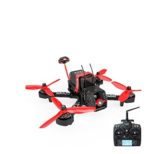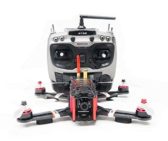The Best Racing Drones in 2021: The Quickest Drones in the Sky

UVify Draco HD
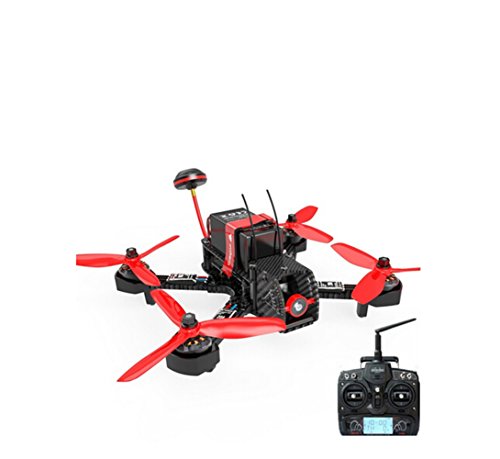
Walkera Furious 215
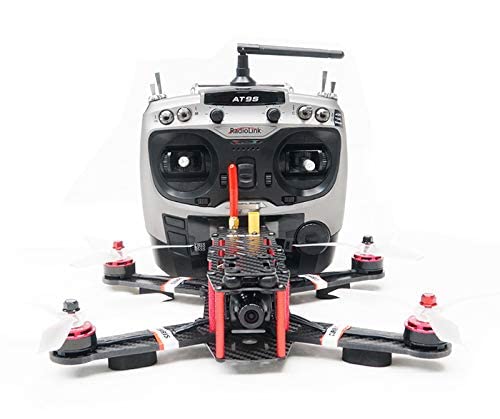
ARRIS X-Speed 250B V3
It is funny how much of our lives are spent in search of hormones. Those looking for camera drones crave that serotonin from likes and shares on their videos. Those of us looking for the best racing drones are searching for that sweet adrenaline.
Our goal here is to fly as fast and handle as effectively as possible. You want a device that can run through obstacles and throw in the odd flip here and there. Some features, like relative global positioning, become less important, while speed and aerodynamics become vital.
To determine the quality of a racing drone, some basic understanding of physics would be beneficial. Thankfully, there are also tests and direct comparisons that can tell us if a drone is doing better than its competitors.
Finally, there is no better way to know which is the best drone for racing than to actually race. That’s exactly what we did before writing this review.
Picking out the cream of the crop when it comes to frequent winners, we can know which one will be best suited to a specific type of drone pilot.
Several technologies have emerged in the last decade which allow drones to become fast, agile, and reliable.
When searching for the best racing drones on the market, it is important to measure not only the number of good features but how they work together. As is the case with any other sport, being great at one thing might not be as strong as being very good at two or three.
A drone with a record-breaking top speed becomes a hunk of plastic and metal if it’s impossible to fly correctly. This means that the controls need to be quick and responsive, and there mustn’t be any lag when it comes to FPV transmission.
Finally, there is the question of value.
It is understandable that having more features will be more expensive. But, we should always investigate if paying a premium is worth it if this will not add much to the overall experience.
The Best Racing Drones (RTF)
We may receive compensation on qualifying purchases via our links. This does not change how we review items. For more information, please read our affiliate disclosure.
The modular build of the Draco HD is designed for speed, performance and reliability.

- Flight Time: ~8 minutes
- Top Speed: 50 mph
- Charge Time: ~60 minutes
- Range: 300m / 960ft
- Remote Controller: WiFi 5.8GHz @ 40 channels (included in the set)
- Camera: 90°Adjustable 720p
- Live Video Transmission Range: 150m / 480ft
- Weight: 485g / 17.10oz (without battery, battery weight: 207g/0.46lbs)
- Working Temperature: -5°C to ~ 40°C
- Rated for indoor and outdoor use
Even when we are talking about a new sport and a hobby made for enthusiasts, one thing remains the same: money talks. For those ready to spend a bit more, the UVify Draco HD is designed to look like the best consumer drones.
But, upon closer inspection, you will realize that this is one of the most effective racing drones on the market. It is exceptionally fast and very agile, qualifying in the top of the range of stock racing drones.
The only downside is that the proprietary connections made to complete the design of the drone make it slightly harder to customize your Draco at home. UVify is trying to compensate this fact by futureproofing the drone with modular components.
But, it is questionable if they will be able to offer everything the market demands.
For now, the components and features of the Draco are top of the line and can easily qualify for any competition with a capable drone pilot behind the controller.
The motor is exceptionally strong, gaining speeds of up to 50mph in good conditions. Additionally, Draco is agile enough to make very sharp turns without losing any altitude.
The need for an exceptionally large transceiver is explained by the fact that there is a 720p camera in the front that can be adjusted up to 90 degrees.
As to provide no latency or lag to the proprietary goggles, the bandwidth is increased significantly, slightly lowering flight time because of that.
A pricey but good value racer drone nonetheless.
+ Pros
- Cons
No products found.
For those looking for a lightning-quick drone without the need to customize it, the Walkera Furious 215 could be what you need.

- Flight Time: ~9 minutes
- Top Speed: Unknown, estimated at 100 mph
- Charge Time: ~90 minutes
- Range: 1500m / 4000ft
- Remote Controller: WiFi 5.8GHz (included in the set)
- Camera: 50°Adjustable TLV1600 camera HAD II CCD
- Live Video Transmission Range: 1000m / 1640.4ft
- Weight: 375g / 13.12oz
- Working Temperature: -10°C to ~40°C
- Rated for indoor and outdoor use
The Walkera Furious 215 that might be slightly harder to mod than the cheaper models but is primed for racing from the start, so less customization is needed.
The casing is made to be crash-resistant and durable. The wings are made from a single piece of thick carbon-fiber plate. This will make it very hard for the drone to be damaged in the case of a fall or a hit.
This model has a mount for your HD camera and GoPro for if you want to take footage during races. But, as this addition will do the opposite of assisting with speed and handling, most pilots will probably opt-out.
Although customization on this model is restricted to more experienced constructors, it is by no means difficult. If you know your connections and your soldering points, changing features on the 215 will be a breeze.
The motor is a strong 2500KV brushless design with solid plastic blades. With them involved, the Walkera will not only be fast enough in straight lines but more than agile enough to cut fast corners.
The FPV camera is adjustable up to 50 degrees, letting you see what is directly in front of you, depending on the speed of the track.
Finally, the transmitter on this model is exceptionally strong. This will allow coverage in almost any course or arena, especially if they are in the open.
+ Pros
- Cons
No products found.
No products found.
One of the most customizable FPV drones in the market, perfect for those serious about building a rapid racer.

- Flight Time: ~7 minutes
- Top Speed: Unknown, estimated at 50mph
- Charge Time: ~90 minutes
- Range: Depending on the transceiver (not included)
- Remote Controller: WiFi 5.8GHz Radiolink AT9
- Camera: 45°Adjustable TLV700 camera
- Live Video Transmission Range: Depending on the transceiver (not included)
- Weight: 400g / 14.10oz
- Working Temperature: 10°C to ~ 40°C
- Rated for indoor and outdoor use
The Arris X-speed 250B v3 is every drone constructor’s dream. Not only does it come with strong components and features, but it also has an open design that can be customized to anyone’s content.
The double-decker chassis protects all of the important components from getting damaged while allowing any drone constructor and enthusiast easy access to all of the components.
All of the wings are made from thick carbon fiber. They are made from separate pieces, meaning that if you break a single wing, you will not need to reassemble the whole chassis, but rather just that wing.
On the side, there is a small screw that will allow you to tilt the camera to your desired angle. This will keep the view fixed during flight and your transmission without any latency.
The camera that comes with the kit is more than acceptable, providing a nice contrast even under lower light. Additionally, it is very easy to exchange the camera for something stronger if you have more faith in your bandwidth.
The motors are brushless Arris 2205 racing pieces, which have shown to be favorites when it comes to racing modded drones. Combined with the 5042 propellers, they will allow for excellent speed and amazing aerial agility.
+ Pros
- Cons
No products found.
A good introduction to the world of drone racing, but won’t win you competitive races.
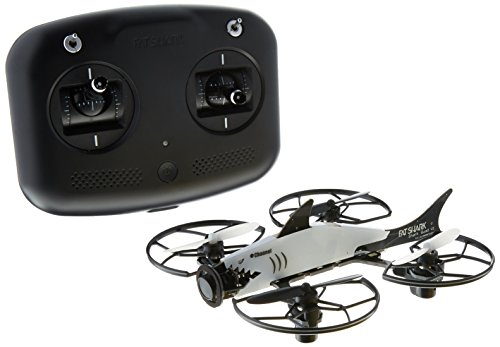
- Flight Time: ~4 minutes
- Top Speed: 20 mph
- Charge Time: ~30 minutes
- Range: 40m / 130ft
- Remote Controller: WiFi 5.8GHz & 2.4GHz (included in the set)
- Camera: 130° CMOS
- Live Video Transmission Range: 21m / 70ft
- Weight: 50g / 1.76oz
- Working Temperature: 10°C to ~40°C
- Rated for indoor and outdoor use
This little drone is incredibly fun to fly, and one of the best ways to enter drone racing as a sport.
The aircraft alone is quite petite, making it possible to fit easily on the palm if needed. Most of the drone is relegated to the relatively large blades that provide a good balance.
In the top, protruding through the mouth of the shark is a large and stable FPV camera with a wide-angle lens that provides good position awareness to the pilot.
With the goggles included in the kit, the visibility is akin to a motorcycle helmet, though without being able to turn your head.
The controller and the goggles are connected with a 5G wireless connection, allowing for quick streaming of analog 360p video to the Fat Shark Recon goggles. This provides the stream with very low latency and no lag at all.
The top speed of this drone is around 20mph, placing it less than professional racing drones. It has brushed motors, which slightly reduce the power of the device itself.
But, for an entry-level racing drone, the Fat Shark 101 is a good way for someone just starting with the sport to learn about different options and to get accustomed to wearing goggles while flying.
Finally, there is a free app that comes with the Fat Shark 101, which will allow you to simulate flight on your computer. The app will give you the ability to learn how to fly and test the physics before you even turn on the drone.
+ Pros
- Cons
No products found.
A fast and effective racer drone that allows for plenty of modding.
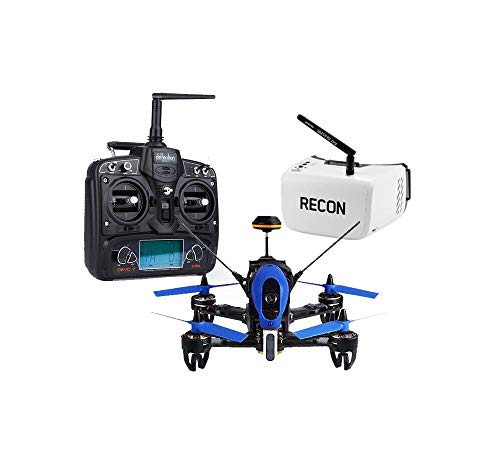
- Flight Time: ~5 minutes
- Top Speed: Unknown, estimated at 50 mph
- Charge Time: ~120 minutes
- Range: 100m / 320ft
- Remote Controller: WiFi 2.4GHz DEVO 7
- Camera: 45°Adjustable TLV700 camera
- Live Video Transmission Range: 50m / 160ft
- Weight: 370g / 13.05oz (without battery)
- Working Temperature: -10°C to ~ 40°C
- Rated for indoor and outdoor use
While Walkera has outdone themselves with this excellent mini racing quadcopter, there is more to the Walkera F210 than meets the eye. This racing drone can support several additions and invert on its axis, making a totally different use for the drone.
The casing is fully modular and made from carbon fiber. The arms are 3mm thick, with the side panels being around half of that. This will improve the durability of your drone if you wish to go to a full manual mode made for racing.
Aside from the manual, there are the horizon and semi-horizon modes that provide varying levels of assistance for anyone just starting as a drone pilot. The full horizon mode will keep the height of the drone stable and make it almost impossible to crash-land.
If you switch to semi, you will be allowed some tilt and even the ability to flip. But, the drone will make an effort to keep its relative level to the ground.
The drone comes ready to fly right out of the box, and there is a high-power controller that will provide more than enough range.
Although the camera is ready to connect to an FPV, Walkera doesn’t provide proprietary goggles to go with this drone. Thankfully, it is possible to connect any type of analog or WiFi-connected goggles.
Finally, the power of the drone is enough for many different types of race track. It can accelerate quickly in varying directions and has a nippy top speed, too.
+ Pros
- Cons
No products found.
No products found.
Learn the ropes of drone flying and racing thanks to three speed modes; beginner, intermediate and racer.
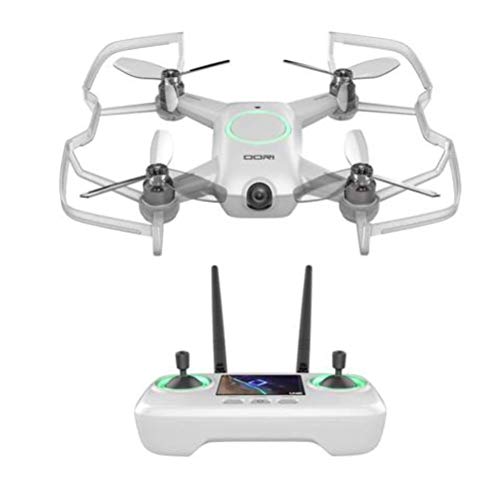
- Flight Time: ~3 minutes
- Top Speed: 50 mph
- Charge Time: ~30 minutes
- Range: 30m / 100ft
- Remote Controller: WiFi 5.8GHz and 2.4Ghz (included in the set)
- Camera: 90°Adjustable 4K Camera with 13MP
- Live Video Transmission Range: 20m / 65ft
- Weight: 73g / 18.34 oz
- Working Temperature: 5°C to ~40°C
- Rated for indoor and outdoor use
This little quad is made with the intent to allow novice drone pilots to spread their proverbial wings and learn everything there is about drone racing. It is quick and agile, while still being very durable to all bumps and crashes.
The drone comes with three modes of flight suitable for different grades of experience.
In the first mode, the sensors will stabilize a drone similar to what you would see in a GPS model. You will not need to worry about height and positioning, as that will be done for you.
The second mode enables throttle control and gives the pilot the ability to feel out how the drone reacts in different circumstances. As the motors are quite strong, you will be able to fly the OOri even in windy conditions — once you master how to compensate for wind speed.
Finally, you can turn all the assistance off. This will allow an expert to make loops and punch-ups, as well as twist and turn free of any restrictions.
The drone uses powerful brushless motors that can propel it up to surprising speeds. When flown in a straight line, it can be like a little white bullet zooming through the air. Its 50 mph top speed is not to be sniffed at.
The FPV camera is made to assist different types of pilots, as well. The varying tilt will give beginners a clear view of what is in front of them. If you tilt the camera upwards, you will have a front view during loops and high speeds, which is important for professionals.
The positioning of the camera also allows for the center of mass to be slightly below the propellers, giving a greater propeller to body ratio.
Once everything is in place, the UVify OOri is suitable for both experienced racers and those just entering the sport.
+ Pros
- Cons
No products found.
The Hawk Pro is potentially the fastest drone in the world with a top speed of up to 100 mph.
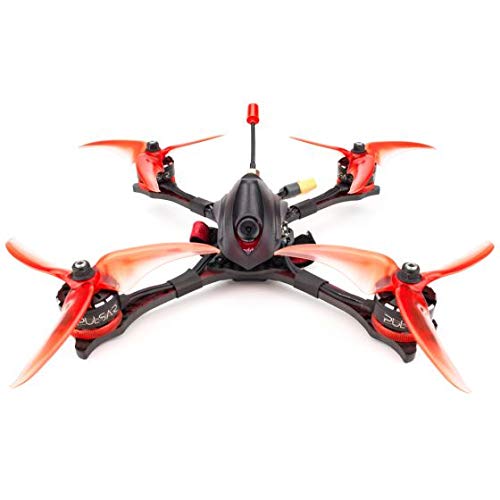
- Flight Time: ~8 minutes (with 1500mAh 4S)
- Top Speed: 100 mph
- Charge Time: ~90 minutes (with 1500mAh 4S)
- Range: 150m / 492ft
- Remote Controller: Frisky XM + receiver (included in the set)
- Camera: Caddx Ratel 1200TVL
- Live Video Transmission Range: 100m / 320ft
- Weight: 265g / 9.34oz (without battery)
- Working Temperature: 10°C to ~40°C
- Rated for indoor and outdoor use
This generation of the EMAX Hawk brings loads of improvements to what used to be a fan favorite between both racing and freestyle drones. With a considerable increase in specs, the Hawk Pro will probably follow its predecessors.
This model has strong motors, fast response time, and a considerable ‘coolness’ factor that comes with all models. The bright LED light underneath the motor on the Pro increase in brightness as you go faster, making them a real crowd-pleaser.
The flight alone is very pleasing, with the strong punch-out and easy low-power loops responding quickly to the controls.
Novice pilots might have some issue with the delicate controllers, as the stick-sensitivity needs some time to get used to. Drone pilots who are used to flying older drones might want to dial the sensitivity down.
The FPV camera is good and has no latency. Because of the analog transmission, the screen quality is a little like an old television set.
The resolution is equivalent to a 600p when digitalized, but as it is analog, the fluency of the colors is much sharper than in digital transmission.
But, if you plan on having more obstacles on your track, you might want to swap the antenna provided with the Pro with something slightly stronger.
Finally, the drone is surprisingly durable. There is no vibration in the camera, and the blades do a wonderful job of protecting the case during crashes. And, as the power of this drone will push you to test your limits, crashes are to be expected.
+ Pros
- Cons
A very cheap option for those looking to test the waters of the drone racing world.
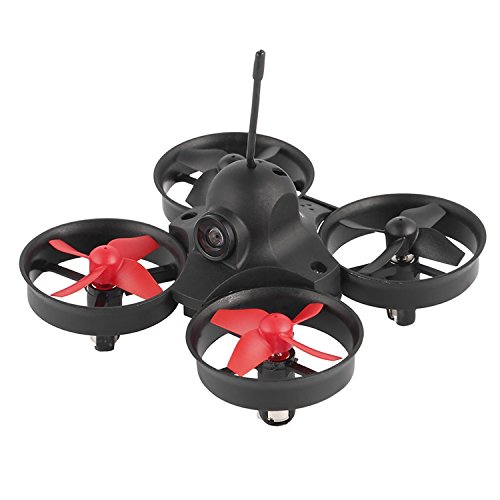
- Flight Time: 6 minutes
- Range: 30m
- Camera: 5.8G 25mW FPV HD camera
- Battery: 200 mAh
- Weight: 25g
If you find that racing is an expensive proposition, maybe the Arris Poke Micro FPV can change your mind.
It’s certainly an inexpensive way to get into FPV racing, even if you have to buy a separate FPV monitor or goggles for it. Yup, that’s its biggest drawback. But there are lots of cheap options out there that it’s a minor issue, at best. Plus, if you’re a racer, this could actually be an advantage, since you have the freedom to get better hardware for your FPV monitor or goggles.
And with that out of the way, let’s get into the Poke’s FPV mode. The built-in camera is a surprisingly robust, low light camera, with the accompanying Video TX that can transmit at 5.8G 25 mW on 48 channels. You can fly this drone at night, and the camera will still be able to pick up the surroundings.
You might scoff at the short 30m range, but remember that this is a racing drone. It sacrifices much of that distance to make transmission much more powerful, leading to smoother video streaming that’s crucial for high-speed racing.
As for flight performance, the Poke Micro is a speedy and zippy drone based on the popular Tiny Whoop model. It’s agile and responsive, and flying it around “feels light” to the touch. It has adjustable speed modes in case you want to fly a little slower.
For a small racing drone, it has one crucial safety feature: Return to Home. With the push of a button, the tiny Poke drone will hone in on your remote controller to land there.
Overall, despite the lack of an included FPV monitor or goggle, the Arris Poke Micro is still a great starter FPV drone. The built-in camera is fantastic, and the handling is incredible. Great for honing your FPV flying skills!
+ Pros
- Cons
Drone Racing: A Quick Guide
It is a great misconception that racing drones have everything to do with speed alone. If that was true, people would use plane-like drones for racing, trying to emulate the US Air Force RQ-4 Global Hawk, which is technically also a drone.
The point of drone racing is the ability to mix speed, agility, as well as the strength of the drone to push through obstacles. For competitions, there are various courses made to test any drone to the limit.
Because of these demands, racing drones are usually narrower than regular recreational drones, but just as dense. Also, the camera is placed slightly above the center of mass, as to simulate the same perspective in humans.
Everything in the drone is gauged so that the pilot feels as if they are inside and flying. They should be a part of the drone and not a separate entity.
‘Be the drone’ is how you win the race!
What is Drone Racing?
Drone racing is a relatively new and emerging sport. It combines aspects from air shows, robot fights, as well as e-sports to provide fun and entertainment for both the participants and the audience.
With the improvements in FPV technology, all modern drone racing is done via virtual reality flying goggles that stream the drone camera feed to the pilot.
Usually, there are two drone pilots that will change during the pit stop to give the other some time to rest and refocus. At that pit stop, they will be able to make any repairs to their drones and exchange the battery.
While the goal of the race is to be the first to pass the finish line, this is not as easy as it sounds. There are different bends, lollipop loops, as well as restrictions where you should fly. Penalty time in the pit can be added if you stray off the course.
Finally, some drone races include solid barriers that drones should push through. These give a handicap to the drone going in first. Variation in obstacles makes it, so that strategy during the race is as important as skill or equipment.
As rules about drone design are still lax, many teams make interesting changes to their drones in both components and overall shape.
What to Look for in a Racing Drone
The features you will be looking for will depend on the type of race you plan to engage in. But, some basic traits should be found in all racing drones, and their quality will be essential for your victory.
The primary feature you should be looking for is the design. Unlike most drones, racing drones have their blades balanced to the center of mass. They will not be above the body of the drone, rather in line with it.
The balance of the drone needs to work in all ways, making the center of weight and power for the drone in the same spot, ideally in the very middle of the craft.
The second main feature is the relative strength of the engine. Racing drones are usually smaller and lighter than commercial drones, but they should have an equally powerful motor that is able to propel and stop the drone in an instant.
Finally, the quality of the FPV system is essential to the pilot. Resolution is important, but the quality of the picture alone is not essential.
The main aspect of the FPV transition should be the lag. The average human response time is around 0.28 seconds, with experienced pilots having that number cut in half. Any lag will be added to this time, making the piloting harder.
Contrast and the refresh-rate are much more important than resolution and color. It is better to have a hypothetical 720p black & white camera at 144Hz than to have a 4K transmission that will lag seconds behind.
How Does a Drone Race Work?
All pilots will start from the same area, usually selected into pole positions with a qualifying round. At the sound of the mark, everyone will fly off and start with the race, trying not to smash into anything.
The course can vary significantly and will depend on who is organizing the event. Homebrew rules are common, but they are becoming more standardized as the sport develops.
The three most common types of track features are poles, grids, and lollipops. Drone pilots will be instructed on which side of the poles and grids to fly, usually by light signals.
Lollipops are large circles that the pilots will need to fly through. They are usually not large enough for three drones to pass at the same time, and some organizers make them dangerous for even two drones.
Finally, there may be some obstacles on the track made to test the durability of the drone. Lollipops may have paper barriers to slightly penalize the first one smashing through. Also, poles might have flags attached that can be picked off for additional points.
As battery size is one of the heaviest components in any drone, deciding on the actual weight will be important. Smaller batteries will make your drone lighter and faster, but you will need to go to the pit stop earlier.
What Are FPV Drones?
First-person view (or FPV) drones have their camera focused on the front. Either via a screen or specialized goggles, the drone pilot can then fly the drone as if they were inside it — seeing exactly what the drone sees.
Features of FPV drones can vary significantly, depending on their desired purpose.
Camera drones, either for filming or surveying, will focus on the quality of the image and the stability of the drone.
Racing drones focus on the frame rate and contrast more as having a close and detailed view of the lollipop wall is something you want to avoid. You will also want a wide viewing angle.
By using goggles similar to VR headsets, you can feel as if you are inside the drone and flying around the obstacles. While the sensation needs some time getting used to, it is very addictive and entertaining.
Are You Ready to Fly, or Build Kits?
While flying is at the forefront of drone racing, it is not the only aspect of the sport. Aside from being a pilot, you can opt to build the best racing drones yourselves.
Building kits are made to allow for modifications and adjustments for any possible scenario. Depending on your proficiency, you can even make a whole new drone by yourself.
Most kits are supplied with different casings, holders, and blades. But, if you are interested in even more changes, you can find almost any component, or even combine multiple kits.
Finally, it is more than OK to put some focus on the aesthetics. We all know that painting on flames will make it go faster.
Conclusion
While they have a lot of functional purposes, drones are meant to be fun and exciting. Flying a drone is the best way to feel like a bird in the air.
And with the FPV camera and goggles on, you will feel like an eagle soaring through tight spaces.
With a bit of practice and maybe even building your own drone from a kit, you will become an ace in no time, qualifying for the top competitions.
Regardless of your preference, the best racing drone will always be the one that brings you the most joy to fly.
This means that there are no strict rules when it comes to what you want in a UAV. Some features and components will always work better than others, but that doesn’t mean that they will always be more fun.
The only advice you should follow is to buy quality over quantity.
Strong and durable components will last longer, give you more value, and usually be more entertaining to use. Additionally, you will have less in-between time with your drones being busted or dysfunctional because of a shoddy part.


